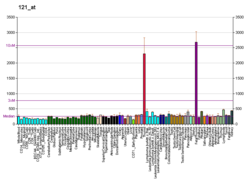PAX8
PAX8(paired box 8)は、ヒトではPAX8遺伝子にコードされるタンパク質である[5]。
機能
[編集]PAX8はPAX(paired box)ファミリーの転写因子である。一般的に、このファミリーのメンバーはpaired boxドメイン、オクタペプチドモチーフ、paired型ホメオドメインを持つ。PAXファミリーは胚発生時の組織と器官の形成や、出生後の一部の細胞の正常な機能の維持に重要な役割を果たしている。これらのタンパク質は、重要なDNA領域に結合し、特定の遺伝子の発現制御を補助する[6]。PAX8は甲状腺の濾胞細胞の発生と甲状腺特異的遺伝子の発現に関与している。PAX8は成長、脳の発生、代謝の調節に重要なホルモンの放出を誘導する。また、腎臓の器官形成の最初期の段階やミュラー管、胸腺でも機能する[7]。さらに、PAX8は腎臓の排出系、子宮頸部の上皮細胞、子宮内膜、卵巣、輸卵管、精嚢腺、精巣上体、膵島細胞、リンパ系細胞で発現している[8]。PAX8やその他の転写因子はDNAに結合して甲状腺ホルモン合成を駆動する遺伝子(Tg、TPO、Slc5a5、Tshr)を調節する役割を果たす。
PAX8(とPAX2)は泌尿生殖系の形態形成の重要な調節因子の1つである。これらは胚の最初の腎臓細胞の指定に関与しており、その発生過程を通じて重要な因子であり続ける[9]。
PAX8はTTF-1と相互作用することが示されている[10]。
臨床的意義
[編集]PAX8は甲状腺の濾胞細胞の形成に必要不可欠であり、PAX8遺伝子の変異は先天性甲状腺機能低下症と関係している[11]。また、PAX遺伝子の調節異常は先天性腎尿路異常(CAKUT)と呼ばれる発生異常を引き起こす[9]。
がん
[編集]PAX8の変異はさまざまな種類のがんと関係している。
機構
[編集]PAX8は「マスターレギュレーター転写因子」であると考えられている[8]。マスターレギュレーターとして、甲状腺特異的遺伝子以外の遺伝子の発現調節も行っている可能性もある。TP53やWT1など既知のいくつかのがん抑制遺伝子が星細胞腫細胞におけるPAX8の転写標的として同定されている。甲状腺腫瘍の90%以上は濾胞細胞由来のものである[8]。一部の甲状腺濾胞癌や甲状腺濾胞型乳頭癌にはPAX8-PPARγ融合タンパク質の関与が示唆されている[12]。PAX8-PPARγによる形質転換の機構はあまり理解されていないが、いくつかの可能性が提唱されている[13][14][15]。
- キメラ型PAX8-PPARγタンパク質によって、ドミナントネガティブ効果によって正常なPPARγの機能が阻害される。
- 野生型PPARγタンパク質の全ての機能ドメインを含むキメラ型タンパク質の過剰発現によって、正常なPPARγの標的が活性化される。
- PAX8の機能の調節不全
- 野生型PPARγ、PAX8経路の双方と無関係な一群の遺伝子の活性化
一部の全ゲノムシーケンシング研究では、PAX8はBRCA1(発がんと関係)、MAPK経路(甲状腺がんと関係)、CCNB1、CCNB2(細胞周期と関係)も標的としていることが示されている。PAX8は腫瘍細胞の増殖と分化、シグナル伝達、アポトーシス、細胞極性、輸送、運動性、接着に関与していることが示されている[8]。
関係するがんの種類
[編集]PAX8/PPARγの組換えは典型的濾胞癌の30–40%を占めるのに対し、膨大細胞腫(Hürthle細胞腫瘍)では5%未満である[16]。
PAX8の発現は腎臓の腫瘍組織、ウィルムス腫瘍、卵巣がん、ミュラー管由来癌腫で上昇している。そのため、PAX8の免疫検出は原発性・転移性腎腫瘍の診断に広く利用されている。PAX8(またはPAX2)の発現の再活性化は小児のウィルムス腫瘍、ほぼすべての種類の腎細胞がん、腎性腺腫、卵巣がん、膀胱がん、前立腺がん、子宮体がんで報告されている[9]。PAX8の発現は子宮頸がんの発生時にも誘導される[17]。
出典
[編集]- ^ a b c GRCh38: Ensembl release 89: ENSG00000125618 - Ensembl, May 2017
- ^ a b c GRCm38: Ensembl release 89: ENSMUSG00000026976 - Ensembl, May 2017
- ^ Human PubMed Reference:
- ^ Mouse PubMed Reference:
- ^ “Entrez Gene: PAX8 paired box gene 8”. 2022年7月30日閲覧。
- ^ “PAX8 gene”. Genetics Home Reference (2016年3月28日). 2016年4月5日閲覧。
- ^ “A comprehensive analysis of PAX8 expression in human epithelial tumors”. The American Journal of Surgical Pathology 35 (6): 816–26. (June 2011). doi:10.1097/PAS.0b013e318216c112. PMID 21552115.
- ^ a b c d “Thyroid transcription factors in development, differentiation and disease”. Nature Reviews. Endocrinology 11 (1): 29–42. (January 2015). doi:10.1038/nrendo.2014.186. hdl:10261/117036. PMID 25350068.
- ^ a b c “Pax genes in renal development, disease and regeneration”. Seminars in Cell & Developmental Biology. Paramutation & Pax Transcription Factors 44: 97–106. (August 2015). doi:10.1016/j.semcdb.2015.09.016. PMID 26410163.
- ^ “The paired domain-containing factor Pax8 and the homeodomain-containing factor TTF-1 directly interact and synergistically activate transcription”. The Journal of Biological Chemistry 278 (5): 3395–402. (January 2003). doi:10.1074/jbc.M205977200. PMID 12441357.
- ^ “* 167415 PAIRED BOX GENE 8; PAX8”. OMIM. 2022年8月2日閲覧。
- ^ “Pax-8-PPAR-γ fusion protein in thyroid carcinoma”. Nature Reviews. Endocrinology 10 (10): 616–23. (October 2014). doi:10.1038/nrendo.2014.115. PMC 4290886. PMID 25069464.
- ^ “Thyroid hormone receptor beta-dependent expression of a potassium conductance in inner hair cells at the onset of hearing”. Proceedings of the National Academy of Sciences of the United States of America 95 (26): 15758–62. (December 1998). Bibcode: 1998PNAS...9515758R. doi:10.1073/pnas.95.26.15758. PMC 28117. PMID 9861043.
- ^ “Mice deficient in the steroid receptor co-activator 1 (SRC-1) are resistant to thyroid hormone”. The EMBO Journal 18 (7): 1900–4. (April 1999). doi:10.1093/emboj/18.7.1900. PMC 1171275. PMID 10202153.
- ^ “Thyroid hormone resistance and increased metabolic rate in the RXR-gamma-deficient mouse”. The Journal of Clinical Investigation 106 (1): 73–9. (July 2000). doi:10.1172/JCI9422. PMC 314362. PMID 10880050.
- ^ “RAS point mutations and PAX8-PPAR gamma rearrangement in thyroid tumors: evidence for distinct molecular pathways in thyroid follicular carcinoma”. The Journal of Clinical Endocrinology and Metabolism 88 (5): 2318–26. (May 2003). doi:10.1210/jc.2002-021907. PMID 12727991.
- ^ “Association of genomic variants at PAX8 and PBX2 with cervical cancer risk”. International Journal of Cancer 149 (4): 893–900. (Apr 27, 2021). doi:10.1002/ijc.33614. PMID 33905146.
関連文献
[編集]- “PAX8, a human paired box gene: isolation and expression in developing thyroid, kidney and Wilms' tumors”. Development 116 (3): 611–23. (November 1992). doi:10.1242/dev.116.3.611. PMID 1337742.
- “Distinct functional properties of three human paired-box-protein, PAX8, isoforms generated by alternative splicing in thyroid, kidney and Wilms' tumors”. European Journal of Biochemistry 228 (3): 899–911. (March 1995). doi:10.1111/j.1432-1033.1995.tb20338.x. PMID 7737192.
- “Chromosomal localization of seven PAX genes and cloning of a novel family member, PAX-9”. Nature Genetics 3 (4): 292–8. (April 1993). doi:10.1038/ng0493-292. PMID 7981748.
- “Oligo-capping: a simple method to replace the cap structure of eukaryotic mRNAs with oligoribonucleotides”. Gene 138 (1–2): 171–4. (January 1994). doi:10.1016/0378-1119(94)90802-8. PMID 8125298.
- “Alternative splicing of Pax-8 gene transcripts is developmentally regulated and generates isoforms with different transactivation properties”. Molecular and Cellular Biology 13 (10): 6024–35. (October 1993). doi:10.1128/mcb.13.10.6024. PMC 364662. PMID 8413205.
- “Mapping of the human homologs of the murine paired-box-containing genes”. Mammalian Genome 4 (2): 78–82. (1993). doi:10.1007/BF00290430. PMID 8431641.
- “Normalization and subtraction: two approaches to facilitate gene discovery”. Genome Research 6 (9): 791–806. (September 1996). doi:10.1101/gr.6.9.791. PMID 8889548.
- “Construction and characterization of a full length-enriched and a 5'-end-enriched cDNA library”. Gene 200 (1–2): 149–56. (October 1997). doi:10.1016/S0378-1119(97)00411-3. PMID 9373149.
- “PAX 8 regulates human WT1 transcription through a novel DNA binding site”. The Journal of Biological Chemistry 272 (49): 30678–87. (December 1997). doi:10.1074/jbc.272.49.30678. PMID 9388203.
- “PAX8 mutations associated with congenital hypothyroidism caused by thyroid dysgenesis”. Nature Genetics 19 (1): 83–6. (May 1998). doi:10.1038/ng0598-83. PMID 9590296.
- “Follicular cells of the thyroid gland require Pax8 gene function”. Nature Genetics 19 (1): 87–90. (May 1998). doi:10.1038/ng0598-87. PMID 9590297.
- “Structural defects of a Pax8 mutant that give rise to congenital hypothyroidism”. The Biochemical Journal 341 (1): 89–93. (July 1999). doi:10.1042/0264-6021:3410089. PMC 1220333. PMID 10377248.
- “Role for p300 in Pax 8 induction of thyroperoxidase gene expression”. The Journal of Biological Chemistry 275 (44): 34100–5. (November 2000). doi:10.1074/jbc.M003043200. PMID 10924503.
- “Id helix-loop-helix proteins antagonize pax transcription factor activity by inhibiting DNA binding”. Molecular and Cellular Biology 21 (2): 524–33. (January 2001). doi:10.1128/MCB.21.2.524-533.2001. PMC 86614. PMID 11134340.
- “Autosomal dominant transmission of congenital thyroid hypoplasia due to loss-of-function mutation of PAX8”. The Journal of Clinical Endocrinology and Metabolism 86 (1): 234–8. (January 2001). doi:10.1210/jcem.86.1.7140. PMID 11232006.
- “A novel mutation (Q40P) in PAX8 associated with congenital hypothyroidism and thyroid hypoplasia: evidence for phenotypic variability in mother and child”. The Journal of Clinical Endocrinology and Metabolism 86 (8): 3962–7. (August 2001). doi:10.1210/jcem.86.8.7765. PMID 11502839.
- “The synergistic activity of thyroid transcription factor 1 and Pax 8 relies on the promoter/enhancer interplay”. Molecular Endocrinology 16 (4): 837–46. (April 2002). doi:10.1210/me.16.4.837. PMID 11923479.
- “Expression of PAX8-PPAR gamma 1 rearrangements in both follicular thyroid carcinomas and adenomas”. The Journal of Clinical Endocrinology and Metabolism 87 (8): 3947–52. (August 2002). doi:10.1210/jcem.87.8.8756. PMID 12161538.
- “The paired domain-containing factor Pax8 and the homeodomain-containing factor TTF-1 directly interact and synergistically activate transcription”. The Journal of Biological Chemistry 278 (5): 3395–402. (January 2003). doi:10.1074/jbc.M205977200. PMID 12441357.
関連項目
[編集]外部リンク
[編集]- PAX8 protein, human - MeSH・アメリカ国立医学図書館・生命科学用語シソーラス
- “Xenbase Gene: Summary for pax8, species: Xenopus tropicalis”. Xenbase. xenbase.org. 2009年7月17日閲覧。 “A Xenopus laevis and tropicalis resource”








